Carretera Austral Part 12: Quellón - Puerto Varas
Originally posted to El Cantar de la Lluvia on Tuesday, March 20, 2007
An early rise, for today we would take the ferry to Quellón. This time we booked the trip in advance, after the near-fiasco at Hornopirén.
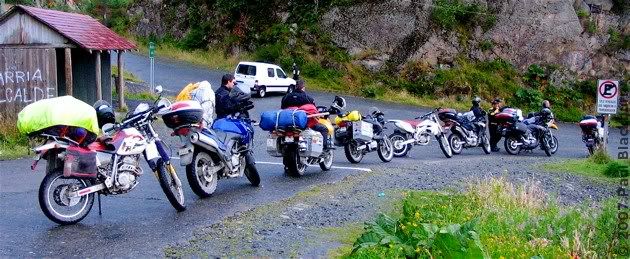

On board we chatted to people here and there. The guy on the CRF was american, biochemist, apparently somewhere in the middle of his second postdoc. He spoke perfect argentine spanish, thanks to having lived some five years in Bariloche with his girlfriend, a bit longer than the time she spent in the US. He told us that he had left behind a job at a good research lab, and didn't know if he wanted to go back.
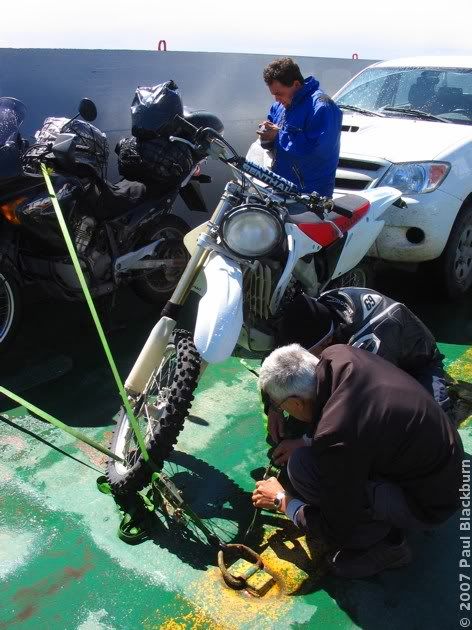
I wandered around the ship a bit, trying to break the monotony of the long journey. I met a german girl, and we chatted for a while in the passenger cabin, located on one of the uppermost levels of the ship, sitting in reclining soft chairs reminiscent of those of long-distance buses.
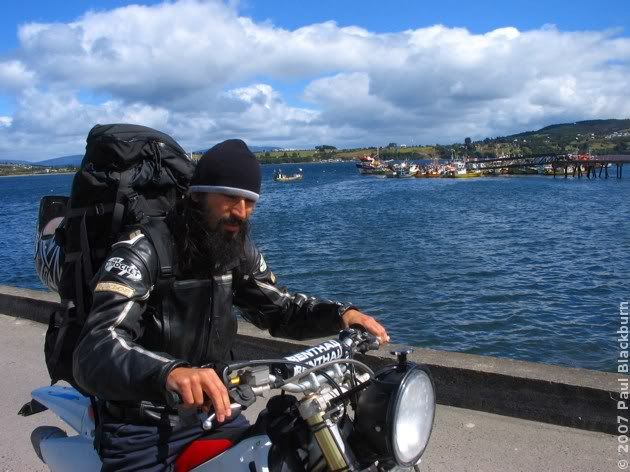
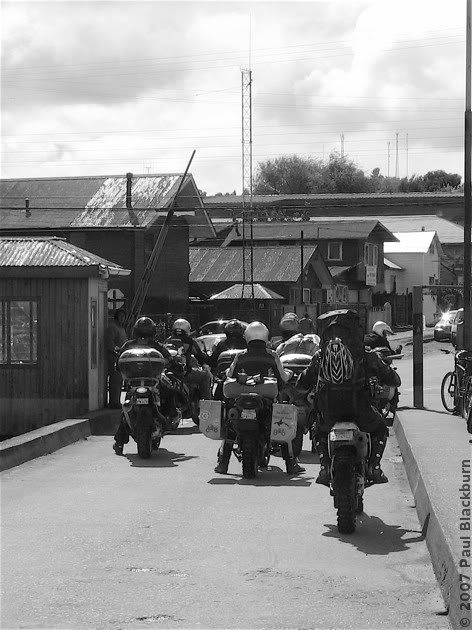
A quick look around before getting off the dock.
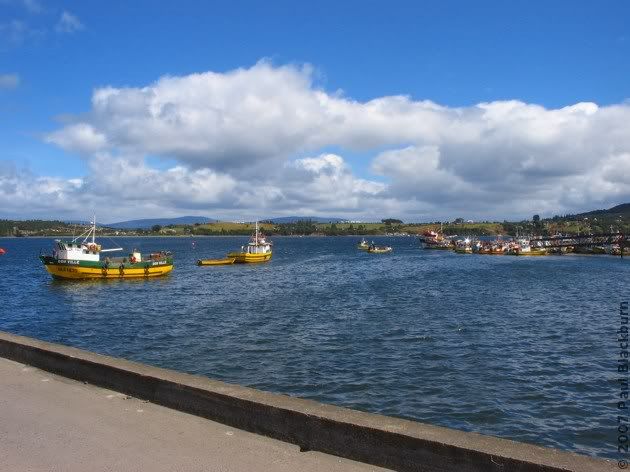
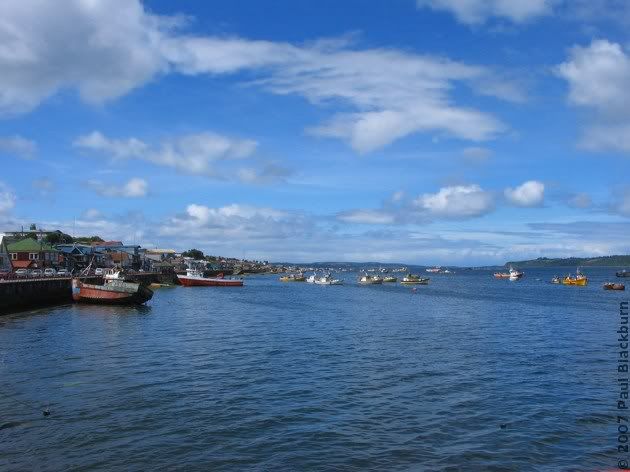
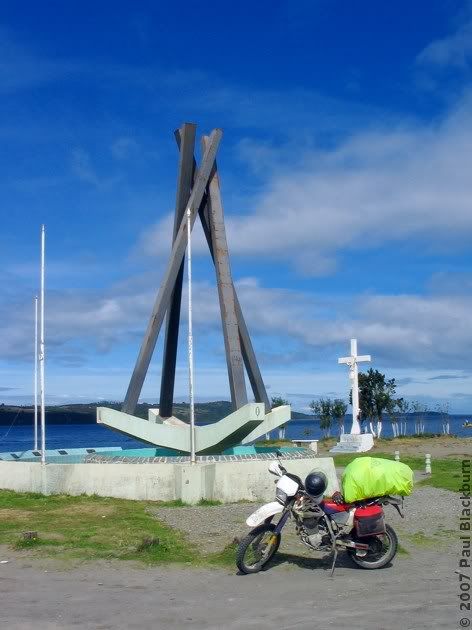
And what about the rest of the pics of Chiloé? What happened?
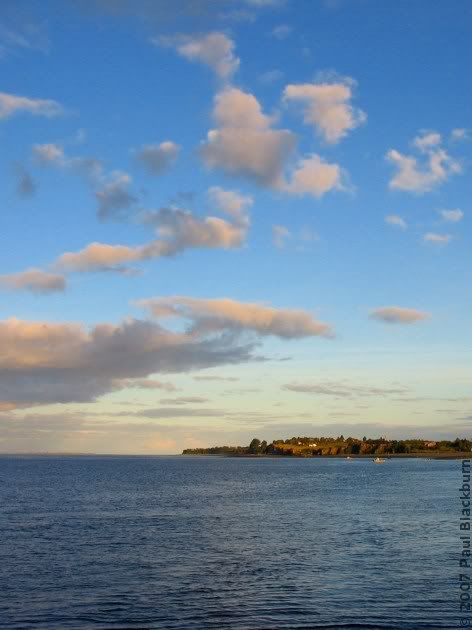
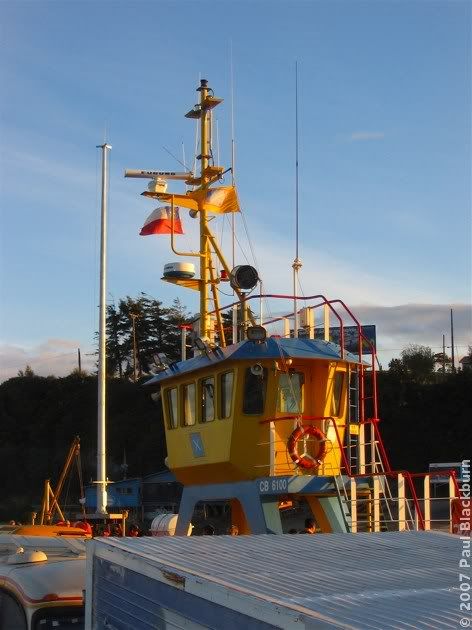
It was strange: we pulled back from one ramp, only to grind to a halt at another, 100 metres to the east of the first. More vehicles were loaded on.



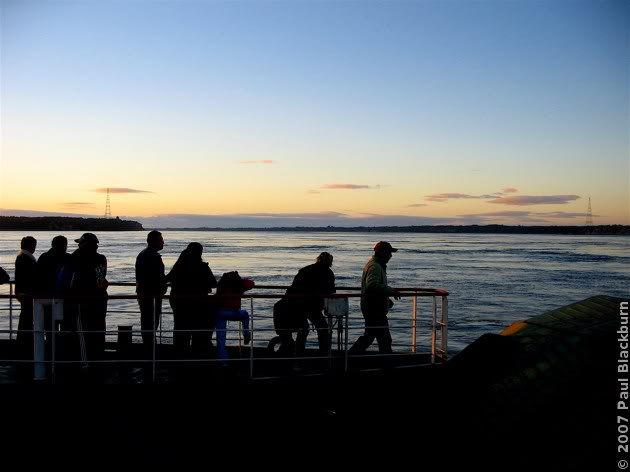
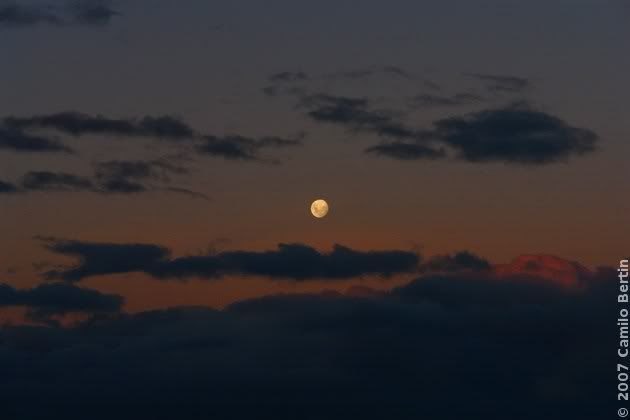
Next Chapter: Volcán Osorno, Valdivia, and the long ride home.
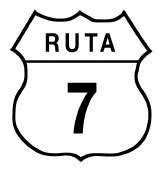 | Day 20: Ferry to Quellón, journey to Puerto Varas. | 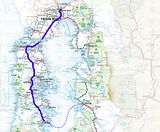 |
An early rise, for today we would take the ferry to Quellón. This time we booked the trip in advance, after the near-fiasco at Hornopirén.
On the loading ramp we met with a surprise: the largest gathering of bikes we saw on the whole trip. Mine, Camilo's, a couple from California (complete with Tool and Ministry stickers on their panniers), a dude on a CRF-450 (more on him later) and a Chilean group of two Transalps, one Varadero and one BMW.

Luckily it wasn't raining. Looking back from the stern, I said goodbye to Chaitén, and to Chile's Deep South.

He showed us his bike. With the help of a friend from the University of Texas they had made a 22 litre gas tank to replace the stock tank, which we learned could only hold 5 litres. He had also bought a giant headlight, and mounted it using a fame he'd made. He told us about the long hours he spent in the lab, poring over website after website of accessories and enhancements for the bike. He spent a year doing this: buying stuff, installing it on the bike, buying more stuff.
We were not too clear on what his route was, but he was certainly doing it fast, and in long, long stretches. His luggage? A medium-sized backpack. No rack, no panniers, saddlebags, nothing. He had left almost everything, including his tools, in Puerto Montt. His back was a wreck, he told us.
Five minutes after setting sail, I heard him cursing emphatically. He thought he had been sold a ticket to Puerto Montt, not to Quellón. As they say, se quería cortar un huevo. He needed to get to Puerto Montt in order to reach Osorno, to get to Moto Aventura. He had a problem with his back wheel, and had heard that they were the best and most complete bike shop in southern Chile, and was certain that he needed their services.
I asked if I could see the back wheel. He said it was loose, and that this was especially noticeable on asphalt. It might be the bearings, he mused. I asked him to raise the bike on the kickstand. "Cómo? Que la levante?, you want me to pick it up?". "No, no: like this". And I showed him how to use the locked front wheel and the kickstand to raise the back wheel off the ground easily.
And indeed, the back wheel was horribly loose. At the rim, it had about a centimetre of lateral motion. A guy watching all of this said: "Son los rayos, it's just the spokes that are loose." So off he went, and came back with an adjustable spanner, and everything was set in ten minutes.

For the first time in my life I began to feel seasick. I closed my eyes, hoping it wouldn't end badly. It was almost impossible to sleep, since the loudspeaker that was surely used for announcements and so on emitted a sanity-melting screech throughout the whole trip, audible and irritating over the hum of the ship's big engines, audible even over the constant loud rattling of some loose wall panel. Such simple things to fix, but that were left as-is, unchanged. Three points off for Naviera Austral, lose a turn, do not pass go.
My seasickness didn't end with a mad rush to the railing, but I did feel the urgent need to get out for fresh air and to stabilize myself with the distant horizon. Ah, the things we'll put up with to talk to a pretty girl.
We arrived at Quellón. Here's a pic of Julius on his CRF.

A bike-jam.



We rode up and down the street a bit, looking for a cocinería with Julius and Camilo. He told us he tried to have two guns shipped down with his bike, but when the customs official finally broke open the container full of traveller's bikes, he didn't let him take his guns. He said he felt naked without them. You've gotta have an edge, you never know, he said.
We said goodbye, and headed South 5 kilometres. This is where the Ruta 5 ends, and is one of the claimed endings of the Pan-American Highway.

Simply that we barely stopped at all. After the desolate and majestic scenery down south, now the rolling hills, colourful Chiloé houses, blacktop and traffic jarred with our state of mind. We stopped at Castro, but the plaza was being restored, frustrating any attempt at getting a good shot of the old church. And the traffic, the people, the noise, and a stomach still rolling to the rhythm of the Golfo Corcovado; all of that dissolved any desire to stop and get to know the area. As a concession, if you want to see a motorbike trip up and down Chiloé, I leave you with
La Ruta de Casi.
La Ruta de Casi.
We reached Chacao at sunset, having travelled the whole length of the island of Chiloé practically nonstop. We buzzed straight to the head of the long column of cars, buses and trucks waiting to board a ferry. This works amazingly well: the vehicles near the loading ramp won't be left off the ferry because, as a motorbike, you skipped the line. The vehicles further back are too far off to be able to manifest their displeasure. When you board, everyone that did manage to get on is happy, and leaves it at that. Everyone else (that might possibly be mad at you) is left on the shore. In any case, we were placed in a dead space on the ferry, so we technically didn't influence the queue at all.
We saw but a couple of toninas, in the distance. Some curious seals came closer.




It is amazing to see the constant flow of ferries crossing the Canal de Chacao.

In the distance, something I had been hoping to see: the cable (only one) that provides power to the whole island, according to what I read in the Turistel Sur, waiting in the small shelter at Puerto Yungay. It hangs from those two towers.

"What if we carry on to Puerto Varas, instead of staying in Puerto Montt again?" I asked Camilo. And so we did.

We got there quite late, and found a residencial in a rather dingy area. That night Camilo went off to the Casino, and I got together with a friend.
I felt a bit uncomfortable. I had become accustomed to tiny towns, hundreds of kilometres of wilderness, dense, dripping forest, windswept lakes and pampa, glaciers as common as the mountaintops they sat on, or, failing that, cities ensconced in hidden valleys or tucked up against towering rock. But so it goes, and we had to go back now. And there was still the lake district further north. I might adapt once more to those surroundings, and I might set up camp somewhere. You never know.
Next Chapter: Volcán Osorno, Valdivia, and the long ride home.
Labels: carreteraaustral, rides, trips

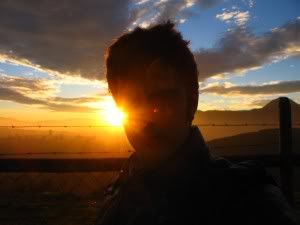
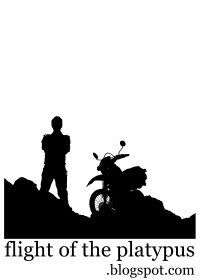

 The Lagoons of the Santuario de la Naturaleza 2: Laguna Los Ángeles
The Lagoons of the Santuario de la Naturaleza 2: Laguna Los Ángeles Race Day At Leyda 4
Race Day At Leyda 4 El Tabo and the Central Hidroeléctrica El Sauce
El Tabo and the Central Hidroeléctrica El Sauce Exploring The Hills Around Lampa
Exploring The Hills Around Lampa A Different Route To Baños De Colina
A Different Route To Baños De Colina The Mines of the Cuesta La Dormida
The Mines of the Cuesta La Dormida The Frozen Lagoons of the Santuario de la Naturaleza
The Frozen Lagoons of the Santuario de la Naturaleza Second Mass Demonstration "For A Fair Tag"
Second Mass Demonstration "For A Fair Tag" First Mass Demonstration Against The 'Tag'
First Mass Demonstration Against The 'Tag' Enduro In Lagunillas
Enduro In Lagunillas Embalse El Yeso and Termas Del Plomo
Embalse El Yeso and Termas Del Plomo Ride To Peñuelas
Ride To Peñuelas Cerro Chena
Cerro Chena Race Day at Leyda 3
Race Day at Leyda 3 Baños de Colina 2
Baños de Colina 2 Carretera Austral: Epilogue
Carretera Austral: Epilogue The Little Giant and Termas del Plomo
The Little Giant and Termas del Plomo Back on Two Wheels
Back on Two Wheels 2006 Photographic Retrospective
2006 Photographic Retrospective Race Day At Leyda 2
Race Day At Leyda 2  Quantum Optics III in Pucón
Quantum Optics III in Pucón Meseta In Chicureo
Meseta In Chicureo Pick Up Your Beer Bottle And Fuck Off
Pick Up Your Beer Bottle And Fuck Off  Planes And Hills
Planes And Hills Cut-Off Road
Cut-Off Road Lagunillas
Lagunillas Laguna Verde 2
Laguna Verde 2 Ride To Anywhere But Aculeo
Ride To Anywhere But Aculeo Cerro El Roble, Second Attempt
Cerro El Roble, Second Attempt Baños De Colina
Baños De Colina Some Walk On Water...
Some Walk On Water... Race Day At Leyda
Race Day At Leyda Almost Cerro El Roble
Almost Cerro El Roble Off To Curacaví with Andrés
Off To Curacaví with Andrés La Serena, Part 3: Back To Santiago
La Serena, Part 3: Back To Santiago  A Bull, Two Cows and a Chilean Fox
A Bull, Two Cows and a Chilean Fox Escape To Cuesta La Dormida
Escape To Cuesta La Dormida Valve Adjustment
Valve Adjustment La Serena, Part 2B: Valle Del Elqui
La Serena, Part 2B: Valle Del Elqui La Serena, Part 2A: Coquimbo and La Recova
La Serena, Part 2A: Coquimbo and La Recova Mud And Pine Trees
Mud And Pine Trees La Serena, Part 1
La Serena, Part 1 Pimp My Exhaust
Pimp My Exhaust Ride To Laguna Verde
Ride To Laguna Verde Ride To La Mina
Ride To La Mina Ride To Termas El Plomo
Ride To Termas El Plomo Camping in Colliguay
Camping in Colliguay Ride To Portillo
Ride To Portillo Ride To Olmué and Con Con
Ride To Olmué and Con Con Siete Tazas
Siete Tazas Watching The Departure Of The Day That Brought Me Here
Watching The Departure Of The Day That Brought Me Here Buenos Aires Motorbikes
Buenos Aires Motorbikes Ride to Talca with the Adach Group
Ride to Talca with the Adach Group Las Trancas '05
Las Trancas '05 Towers and Hills
Towers and Hills María Pinto, Melipilla, Aculeo
María Pinto, Melipilla, Aculeo Me and my Carb
Me and my Carb




0 Comments:
Post a Comment
<< Home